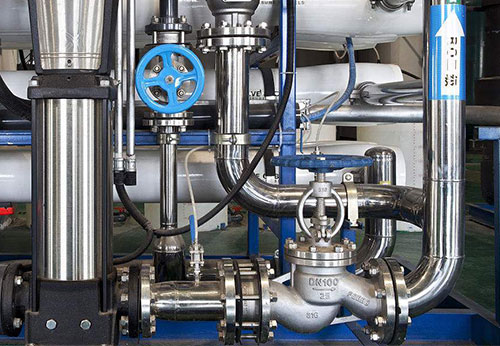Commonly used valves in petrochemical industry
Posted by Bundor valve
In petrochemical plants, valves are an important part of petrochemical pipeline systems. In petrochemical pipelines, most of the medium that in contact with the valve is inflammable, explosive, toxic and corrosive, and the process is complex, the process conditions are harsh, and the start-up period is long. Once the valve fails during production, it will lead to There are serious consequences such as medium leakage and environmental pollution, so petrochemical production has relatively high quality requirements for valves.
In petrochemical projects, valve investment accounts for about 40~50% of the equipment piping costs. The main functions of the valve are to connect and cut off the medium; to prevent the back flow of the medium; to adjust the pressure and flow of the medium; to prevent the pressure of the medium from exceeding the specified value to ensure the safe operation of the pipeline or equipment.
Commonly used valves in petrochemical industry are: gate valve, globe valve, check valve, ball valve, butterfly valve, knife gate valve, etc.
Selection principles of petrochemical valves

1. The nature of the fluid being transported
Valves are used to control fluids, and the properties of fluids are various, such as liquids, gases, steam, slurry, suspensions, viscous liquids, etc., and some fluids also contain solid particles, dust, chemicals, etc. . Therefore, when choosing a valve, we must first understand the properties of the fluid, such as whether the fluid contains suspended solids? Is it possible to vaporize when the liquid is flowing? Where to vaporize? Does the gas liquefy when it flows? How corrosive is the fluid? When considering the corrosiveness of the fluid, it should be noted that the corrosiveness of a mixture of several substances is often completely different from that of a single composition.
3. Valve size
The valve is sized according to the flow rate of the fluid and the allowable pressure loss. Generally, it should be consistent with the size of the process piping.
4. Pressure loss
A considerable part of the pressure loss in the pipeline is caused by the valve. Some valve structures have high resistance and some have low resistance. When various valves have their inherent functional characteristics. Some valves of the same form have large resistance and some have small resistance. Appropriate consideration should be given when selecting.
5. Material of valve
When the pressure, temperature class and fluid characteristics of the valve are determined, the appropriate material should be selected. Different parts of the valve such as valve body, gland, valve disc, valve seat, etc., may be made of several different materials to obtain the best effect of economy and durability. The maximum allowable temperature of cast iron valve body is 200℃; the steel valve body can be used at 425℃; if it exceeds 425℃, alloy steel material should be considered. For valves that transport chemically corrosive media, anti-corrosion material linings can also be used.
6. Temperature and pressure
The material and pressure rating of the valve should be determined according to the operating temperature and pressure of the valve.
In petrochemical projects, valve investment accounts for about 40~50% of the equipment piping costs. The main functions of the valve are to connect and cut off the medium; to prevent the back flow of the medium; to adjust the pressure and flow of the medium; to prevent the pressure of the medium from exceeding the specified value to ensure the safe operation of the pipeline or equipment.
Commonly used valves in petrochemical industry are: gate valve, globe valve, check valve, ball valve, butterfly valve, knife gate valve, etc.
Selection principles of petrochemical valves

1. The nature of the fluid being transported
Valves are used to control fluids, and the properties of fluids are various, such as liquids, gases, steam, slurry, suspensions, viscous liquids, etc., and some fluids also contain solid particles, dust, chemicals, etc. . Therefore, when choosing a valve, we must first understand the properties of the fluid, such as whether the fluid contains suspended solids? Is it possible to vaporize when the liquid is flowing? Where to vaporize? Does the gas liquefy when it flows? How corrosive is the fluid? When considering the corrosiveness of the fluid, it should be noted that the corrosiveness of a mixture of several substances is often completely different from that of a single composition.
- Valve function
3. Valve size
The valve is sized according to the flow rate of the fluid and the allowable pressure loss. Generally, it should be consistent with the size of the process piping.
4. Pressure loss
A considerable part of the pressure loss in the pipeline is caused by the valve. Some valve structures have high resistance and some have low resistance. When various valves have their inherent functional characteristics. Some valves of the same form have large resistance and some have small resistance. Appropriate consideration should be given when selecting.
5. Material of valve
When the pressure, temperature class and fluid characteristics of the valve are determined, the appropriate material should be selected. Different parts of the valve such as valve body, gland, valve disc, valve seat, etc., may be made of several different materials to obtain the best effect of economy and durability. The maximum allowable temperature of cast iron valve body is 200℃; the steel valve body can be used at 425℃; if it exceeds 425℃, alloy steel material should be considered. For valves that transport chemically corrosive media, anti-corrosion material linings can also be used.
6. Temperature and pressure
The material and pressure rating of the valve should be determined according to the operating temperature and pressure of the valve.
 简体中文
简体中文 Русский
Русский Español
Español Bundor - Butterfly, Gate, Check, Ball, Globe Valve Manufacturer, Supplier & Distributor
Bundor - Butterfly, Gate, Check, Ball, Globe Valve Manufacturer, Supplier & Distributor
